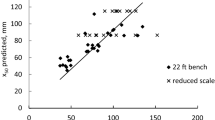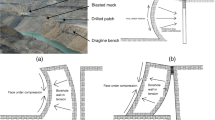Abstract
Drilling and blasting techniques persist as the most economically viable approaches for rock excavation in both surface and underground mining. However, the conventional focus has predominantly cantered on optimizing rock fragmentation, often overlooking the consequential impacts of by-products, such as ground vibration and fly rock. The core objective, which is not entirely met by the current utilization of explosive energy for rock mass breakage, reveals that a mere 20–30% of the explosive energy effectively contributes to shattering the rock mass. The remaining percentage is dissipated as ground vibration, air blast, noise, fly rock, back breaks, and other ancillary effects. This investigative endeavor involved a comprehensive examination of an operational mine, incorporating a series of blast exercises to systematically evaluate the impact of various blast design parameters, including burden, spacing, stemming length, bench height, powder factor, explosive quantity, and maximum charge/delay. For the interpretation and analysis of results, sophisticated software and instrument such as Wipfrag and Minimate Plus seismograph were employed. The unveiled findings indicate that specific blast design parameters, such as a burden of 4 m, spacing of 5 m, stemming length of 5 m, bench height of 6 m, powder factor of 2.25 te/kg, and maximum charge/delay between 55 and 60 kg, were instrumental in yielding favorable blasting outcomes. These parameters led to mean fragmentation sizes below 100 mm and peak particle velocities below 10 mm/s, thereby highlighting the potential for enhanced efficiency in rock excavation through meticulous blast design considerations.




















Similar content being viewed by others
Data availability
The data used to support the findings of this study are available from the corresponding author upon request.
References
S. Bhandari (1997). Engineering rock blasting operations.
T.N. Singh, Artificial neural network approach for prediction and control of ground vibrations in mines. Min. Technol. 113(4), 251–256 (2004)
M. Khandelwal, T.N. Singh, Application of an expert system to predict maximum explosive charge used per delay in surface mining. Rock Mech. Rock Eng. 46(6), 1551–1558 (2013)
M. Khandelwal, M. Saadat, A dimensional analysis approach to study blastinduced ground vibration. Rock Mech. Rock Eng. 48(2), 727–735 (2015)
M. Hajihassani, D. JahedArmaghani, M. Monjezi, E.T. Mohamad, A. Marto, Blast-induced air and ground vibration prediction: a particle swarm optimization-based artificial neural network approach. Environ. Earth Sci. 74(4), 2799–2817 (2015)
A.A. Tealeb, M. Sobaih, A.A. Mohamed, K. Abdel-Rahman, Stress level estimation for the ground beneath the 15TH of May city buildings, Helwan, Cairo, Egypt. Acta Geodaetica et Geophys Hungarica 38(4), 429–443 (2003)
B. Chateau, J. Peterken, A. Caron, L. Chapdelaine, A. Hagon, C. Druitte, La régionalisation de la radio-télévision de service public, organisation et programmes. Etudes de Radio-Télévision. Les Cahiers RTB Bruxelles 32, 1–123 (1983)
N.R. Thote, D.P. Singh, Necessity of blast fragmentation assessment and correlation of rock parameters with blasting performances-a practical approach. Indian Min. Eng. J. 19–23 (1997).
U.K. Pal, N. Ghosh, Optimization of blast design parameters at SonepurBazari opencast project. Indian Min. Eng. J. 41 (2002).
D.E. Siskind, Structure response and damage produced by ground vibration from surface mine blasting (Vol. 8507). US Department of the Interior, Bureau of Mines (1980).
N Ambraseys, Rock mechanics in engineering practice. 1968: Wiley, 111 River Street Hoboken, NJ 07030-6000 USA. p.455
N.S. Chandrahas, B.S. Choudhary, M.S. Venkataramayya, Competitive algorithm to balance and predict blasting outcomes using measured field data sets. Comput. Geosci. 27, 1087–1110 (2023). https://doi.org/10.1007/s10596-023-10254-x
N.S. Chandrahas, B.S. Choudhary, M.V. Teja, M.S. Venkataramayya, N.S.R.K. Prasad, XG boost algorithm to simultaneous prediction of rock fragmentation and induced ground vibration using unique blast data. Appl. Sci. 12(10), 5269 (2022). https://doi.org/10.3390/app12105269
S. Chandrahas, B.S. Choudhary, N.S.R. Prasad, V. Musunuri, K.K. Rao, An Investigation into the Effect of Rockmass Properties on Mean Fragmentation. Arch. Min. Sci. 66, 561–578 (2021)
N.S. Chandrahas, B.S. Choudhary, M.S. Venkataramayya, Firing pattern and spacing burden ratio selection in jointed overburden benches using unmanned aerial vehicle and artificial intelligence based tool. in Proceedings of the second international conference on emerging trends in engineering (ICETE 2023). https://doi.org/10.2991/978-94-6463-252-1_134
D. Ramesh, N.S. Chandrahas, M.S. Venkatramayya, M. Naresh, P. Talari, D.U.V.D. Prasad, K.S. Kumar, V.V. Kumar, Effects of spacing-to-burden ratio and joint angle on rock fragmentation: an unmanned aerial vehicle and AI approach in overburden benches. Acadlore Trans. Geosci., 2(3), 155–166. https://doi.org/10.56578/atg020303 (2023)
O.Y. Odeyemi, B.O. Taiwo, O. Alaba, Influence of explosive maximum instantaneous charge on blasting environmental impact. J. Sustain. Min. 22(4), 343 (2023)
B.O. Taiwo, Effect of charge load proportion and blast controllable factor design on blast fragment size distribution. J. Brill. Eng. 3(4658), 1 (2022)
Z. Zhang, X. Qiu, X. Shi, Z. Luo, H. Chen, C. Zong, Burden effects on rock fragmentation and damage, and stress wave attenuation in cut blasting of large-diameter long-hole stopes. Rock Mech. Rock Eng., 1–19 (2023).
B.O. Taiwo, F. Yewuhalashet, O.B. Ogunyemi, V.A. Babatuyi, E.I. Okobe, E.A. Orhu, Quarry slope stability assessment methods with blast induced effect monitoring in Akoko Edo, Nigeria. Geotech. Geol. Eng. 41(4), 2553–3257 (2023)
Z. Hong, M. Tao, M. Zhao, J. Zhou, H. Yu, C. Wu, Numerical modelling of rock fragmentation under high in-situ stresses and short-delay blast loading. Eng. Fract. Mech. 293, 109727 (2023)
B.O. Taiwo, Y. Fissha, T. Palangio, A. Palangio, H. Ikeda, N.R. Cheepurupalli, Y. Kawamura, Assessment of charge initiation techniques effect on blast fragmentation and environmental safety: an application of WipFrag software. Mining 3(3), 532–551 (2023)
M.S. Venkataramayya, N. Sri Chandrahas, B.S. Choudhary, Identification of most influencing blast design parameters on mean fragmentation size and muckpile by principal component analysis. Int. J. Innov. Technol. Explor. Eng. Blue Eyes Intelligence Engineering & Sciences Publication, 201
M. Esmaeili, A. Salimi, C. Drebenstedt, M. Abbaszadeh, A. Aghajani Bazzazi, Application of PCA, SVR, and ANFIS for modeling of rock fragmentation. Arab. J. Geosci. 8, 6881–6893 (2014). https://doi.org/10.1007/s12517-014-1677-3
Funding
This research received no external funding.
Author information
Authors and Affiliations
Corresponding author
Ethics declarations
Conflicts of interest
The authors declare no conflict of interest.
Ethical statement
Authors state that the research was conducted according to ethical standards.
Additional information
Publisher's Note
Springer Nature remains neutral with regard to jurisdictional claims in published maps and institutional affiliations.
Rights and permissions
Springer Nature or its licensor (e.g. a society or other partner) holds exclusive rights to this article under a publishing agreement with the author(s) or other rightsholder(s); author self-archiving of the accepted manuscript version of this article is solely governed by the terms of such publishing agreement and applicable law.
About this article
Cite this article
Naresh, M., Sri Chandrahas, N., Praful Kumar, G. et al. Harmonizing Blasting Efficiency: A Case Study on Evaluation and Optimization of Fragmentation Size and Ground Vibration. J. Inst. Eng. India Ser. D (2024). https://doi.org/10.1007/s40033-024-00730-8
Received:
Accepted:
Published:
DOI: https://doi.org/10.1007/s40033-024-00730-8




